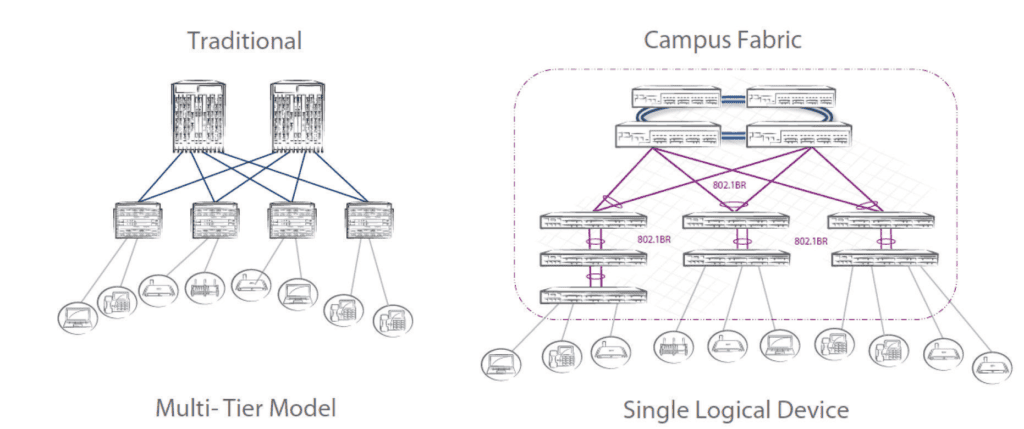Meeting The Requirements of the High-Performance Enterprise
Enterprise networks have evolved from being utilities used by a limited selection of employees within an organisation, to become mission-critical infrastructure that supports every business function. The services that networks support are now central to the operation of every function; manufacturing data, stock control, accounting records, customer order management, or simply voice and video communication. Everything depends on the network. If the network is going to keep up with the demands of business it must be fast, flexible and secure but most of all it must be optimised for both performance and cost.
CommScope has a long history of innovation in wired and wireless networking, driving the technologies forward to offer ever greater levels of performance, efficiency, evolving solutions to meet emerging requirements. The ICX range of switches were designed from the ground up to deliver the performance of a chassis system in a compact, cost effective and flexible package.
RE-ARCHITECTING THE NETWORK: SCALE-OUT VS. SCALE-UP

Traditional network architectures typically demand large power-hungry chassis-based devices in the aggregation and core layers of a campus network. In the past, these were necessary to provide the required resiliency and scale, but they are often underutilised within a compromised network design. This resulted in increased operational costs that could mainly be attributed to disproportionately high-power consumption and cooling expenses, often as a result of an underutilised chassis with empty slots and over specified power supplies which were sized to support a chassis full of the most power hungry cards. To address the limitations of chassis solutions, RUCKUS introduced the concept of scale-out networking. Scale-out networking exploits the Distributed Chassis architecture.
Scale-out networking delivers flexible deployment options using the RUCKUS ICX 7000 stackable switches that can be interconnected to create a unified system. Such a system delivers the single point of management of a chassis-based system, but with greater scalability and power efficiency matched with true pay-as-you-grow economics.
Distributed chassis switches offer scaling that is very often beyond what is possible with a chassis. For example, a stack of 12 x ICX 7650 switches deliver 576 downstream ports at speeds of 1/2.5/5/10GbE which can all operate at line rate concurrently. Copper ports can deliver up to 90Watts of 802.3bt compliant PoE power per port ensuring that all the latest applications and end-point configurations can be supported. In addition to the downstream ports such a system can also support multiple 10GbE, 40GbE and 100GbE connections which can be used for either stacking, computer or uplink connections. This level of scalability combined with flexible deployment options allows the creation of highly customised and optimised solutions that cannot be matched by a rigid chassis-based system.
For high-performance network core applications, the ICX 7850 provides support for 10, 25, 40 and 100GbE connections which when stacked offers unprecedented levels of performance and scalability, a single system can deliver up to 384 40/100GbE ports which can all operate at line rate concurrently in a non-blocking system.
All the RUCKUS ICX 7000 platform families support up to 12 switches per stack ensuring that the benefits of scale-out networking can be exploited in all sizes of deployment and at all layers of the network.
CommScope continues to innovate in this arena, ensuring that the network is always optimised for performance, energy efficiency and management simplicity.
CAMPUS FABRICS—DELIVERING THE NEXT GENERATION THE CAMPUS NETWORK

Built on the ICX 7000 platforms the RUCKUS Campus Fabric solution collapses multiple network layers into a single logical device, combining the power of a Distributed Chassis design with the flexibility and cost-effectiveness of stackable switch building blocks. The result is a unified system that simplifies deployment and management while unifying features and services across the campus.
DEPLOYMENT OPTIMISATION
In order to optimise the cabling within a campus network it is necessary to place the edge switches as close as possible to the devices which they will serve, as this ensures that the length of the cable runs are minimised and the cable management headaches associated with centralised chassis based solutions are eliminated. This reduces the cost of deployment and makes it simpler to build in resiliency by having cable runs from different wiring closets serving different areas of a building. Furthermore, shorter cable runs reduce the power loss on PoE connections, thus reducing the load on the switch power supplies and saving energy, something that is becoming increasingly important as the number and power consumption of PoE devices increases.
Stackable switches are perfectly optimised for distributed deployment allowing ports to be placed precisely where they are needed and ensuring that all cable runs are as short as possible.
PAY-AS-YOU-GROW—CHASSIS CAPABILITIES, STACKABLE PRICES
RUCKUS redefines the economics of enterprise networking by providing chassis-like levels of performance and availability matched with the flexibility of fixed form factor stackable platforms.
One of the biggest challenges that chassis-based systems pose is the up-front costs associated with the system infrastructure (chassis, power supplies, switching matrix, etc.) that must be borne even when deploying a small number of ports. When building a network, consideration must always be given to likely future growth, both in terms of the number of connected devices and also the traffic volumes that it will be required to carry. Therefore, the sizing of the chassis is critical if highly disruptive “fork-lift” upgrades are to be avoided, as demand grows and the result is often that systems are over-specified, creating a very high initial cost and the deployment of underutilised and unnecessarily power-hungry systems.
By contrast, stackable switches offer true pay-as-you-grow economics with a lower cost-per-port whether you are deploying large numbers of 10/100/1000 Mbps edge ports, Multigigabit (2.5/5/10 Gbps) ports or high density 10/40/100 Gbps core systems. With each switch that is added to the system the forwarding capacity is increased in line with the increase in port count, thus ensuring that performance is never compromised.
Furthermore, as each device is added to the system the number of Inter Switch Links (ISL) is increased, as the connections between the devices are an extensible backplane that grows as the system expands, ensuring line-rate and nonblocking performance at all times.
NO COMPROMISE PERFORMANCE
RUCKUS’ Distributed Chassis solution delivers flexible deployment options that allow ports to be located where they are needed while providing a fully extensible high speed backplane that is sized to match the capacity of the base platform. RUCKUS’ ICX 7000 series platforms offer the following Distributed Chassis bandwidths:

ENERGY EFFICIENCY
As there are no empty slots in a Distributed Chassis solution, its power consumption is directly related to the number of ports deployed. With chassis-based solutions, power and cooling are sized assuming that the chassis is fully populated with the most power-hungry cards, that are over specified and therefore not optimised. The net result is that chassis based systems typically suffer from unnecessarily high power consumption, which in turn drives up the cooling requirements, further increasing the Total Cost of Ownership (TCO) of the complete system.
When the deployment of a network is optimised to ensure that it is precisely sized for the application, without compromising scalability or performance, the impact on the overall power consumption of the system is significant. CommScope continues to innovate in this area, ensuring that the network is always optimised for both performance and energy efficiency.
CONCLUSION
In the past, only chassis-based systems could offer the performance, scale and resilience that organisations demand in critical areas of their networks, but advances in processor and software technology mean that today stackable fixed form factor switches can comfortably meet or exceed the most demanding requirements. As a result, the latest fixed form factor switches offer the most cost-effective solution to acquire and operate without the need to compromise on functionality or performance.
Designed to meet the most demanding technical and commercial requirements, RUCKUS’ ICX range of edge switches allow the creation of highly scalable and reliable networks that ensure that every enterprise is equipped to support the most demanding applications. And when combined with innovative solutions such as Campus Fabrics, enterprises can build highly converged networks while minimising operational overheads.
Get in touch now with Nextro Team if you want to know more about how to transform your company into a High-Performance Enterprise,
